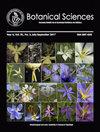玛雅农村社区maax ik (Capsicum annuum var. glabriusculum (Dunal) Heiser & Pickersgill)的生态知识、利用和管理
IF 0.7
4区 生物学
Q3 PLANT SCIENCES
引用次数: 0
摘要
背景:年椒(Capsicum annuum var. glabriusculum)是世界上大多数重要经济辣椒的祖先。它广泛分布在整个墨西哥,目前所有的土著群体都与这种植物相互作用。在尤卡坦半岛,野生辣椒被玛雅人称为maax ik。虽然该地区已被公认为智利的驯化和多样化中心,但对该物种的民族植物学研究仍然有限。问题:当地人对max ik有哪些生态知识?在哪里以及如何收集和管理max ik ?max ik目前有什么用途?研究地点和日期:圣贝纳多,尤卡坦。Summer-Autumn 2021。方法:深度半结构化访谈和参与式观察。确定了管理实践,并估计了管理强度。结果:被调查者知道大鲵有性繁殖,并认识到鸟类在其种子传播中的作用。Maax ikk主要采自可种植该物种的家庭花园,同时还进行了其他非选择性的早期管理措施,如保护和促进。果实在不伤害植物的情况下收获,通常只收获一小部分果实。告密者基本上把牛奶当作食物。管理强度指数较高(5)。结论:Maax ik是一种可持续利用和非选择性管理的营养性食物资源,在圣贝纳多,尤卡坦。本文章由计算机程序翻译,如有差异,请以英文原文为准。
Ecological knowledge, use and management of maax ik (Capsicum annuum var. glabriusculum (Dunal) Heiser & Pickersgill) in a rural Mayan community
Background: Capsicum annuum var. glabriusculum is the ancestor of most of the economically important chiles in the world. It is widely distributed throughout Mexico, and currently all indigenous groups interact with this plant species. On the Yucatan Peninsula wild chile is known as maax ik by the Maya. Although this area has been recognized as a domestication and diversification center of chile, ethnobotanical research on this species is still limited.
Questions: What ecological knowledge do local people have about maax ik? Where and how is maax ik gathered and managed? What uses does maax ik currently have?
Studied species: Capsicum annuum var. glabriusculum
Study site and dates: San Bernardo, Yucatan. Summer-Autumn 2021.
Methods: In-depth semi-structured interviews and participatory observation. The management practices were identified, and management intensity was estimated.
Results: Informants knew that maax ik reproduces sexually and recognized the role of birds in its seed dispersal. Maax ikwas mainly gathered from homegardens where this species was tolerated and other non-selective incipient management practices such as protection and promotion were also carried out. Fruit was harvested without harming the plant and only a small portion of the available fruit was usually taken. The informants used maax ik essentially as food. The management intensity index was relatively high (5).
Conclusions: Maax ik is a sustenance food resource that is sustainably used and non-selectively managed in homegardens by our informants in San Bernardo, Yucatan.
求助全文
通过发布文献求助,成功后即可免费获取论文全文。
去求助
来源期刊

Botanical Sciences
Agricultural and Biological Sciences-Plant Science
CiteScore
1.90
自引率
21.40%
发文量
71
审稿时长
16 weeks
期刊介绍:
Botanical Sciences welcomes contributions that present original, previously unpublished results in Botany, including disciplines such as ecology and evolution, structure and function, systematics and taxonomy, in addition to other areas related to the study of plants. Research reviews are also accepted if they summarize recent advances in a subject, discipline, area, or developmental trend of botany; these should include an analytical, critical, and interpretative approach to a specific topic. Acceptance for reviews will be evaluated first by the Review Editor. Opinion Notes and Book Reviews are also published as long as a relevant contribution in the study of Botany is explained and supported.
 求助内容:
求助内容: 应助结果提醒方式:
应助结果提醒方式:


